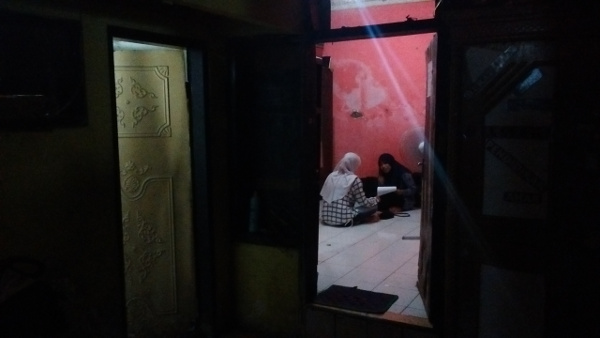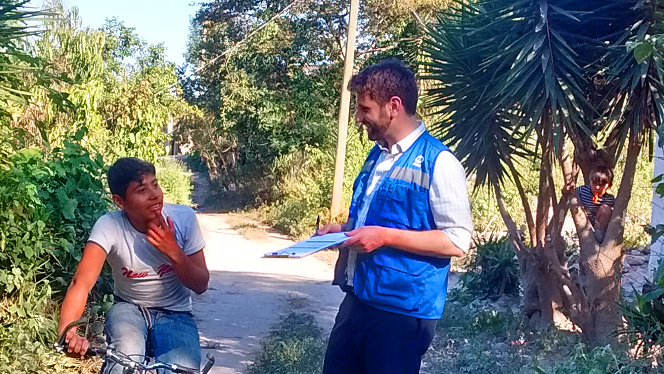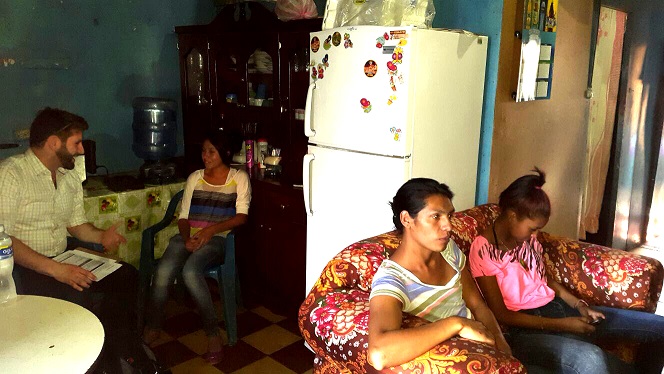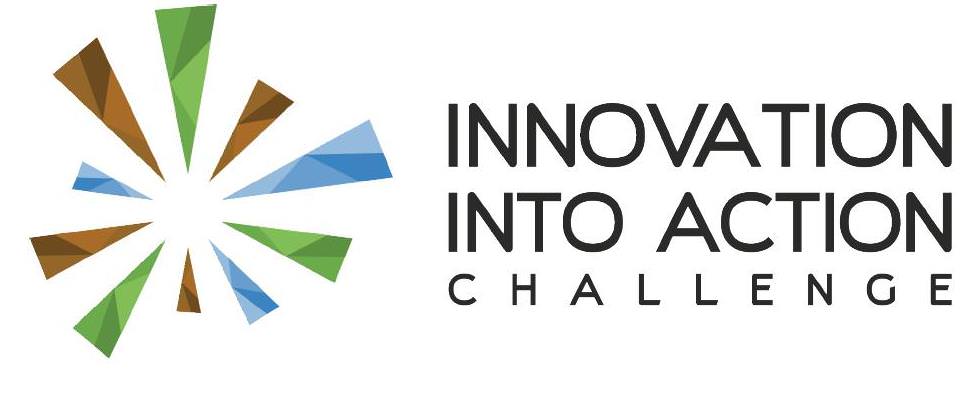The Digital for Development field has enormous potential—and plenty of room for learning. We launched this blog as part of our own learning process, and we hope to engage the Digital for Development community as we find our way forward.
Archived Posts
Appified: How Social Media is Doing the Hard Work in ICT4D
A spoonful of sugar helps the medicine go down, in a most delightful way. Mary Poppins was on to something significant in user experience, far before that phrase even entered our lexicon. How has the sugary sweet world of social media changed the game in ICT for development (ICT4D)? More than just providing us with new channels to engage our target audiences, social media has actually taught our beneficiaries how to be a mobile audience.
App-a-Thon 2016: BlackBerry Messenger for Development
As we’ve ramped up our Digital Insights work over the last few months, we’ve had the opportunity to talk with people around Africa, Asia, Latin America, and the Middle East about the digital tools they use to stay in touch with each other and the world around them. These conversations have reminded us that we have to work hard to stay on top of the growing number of messaging apps on the market today, as what was popular six months ago might no longer be today. “App-a-Thon 2016” is our way of quickly immersing ourselves in different messaging apps to learn about their functionality, look, and feel. How does it work? The entire DAI ICT team signs up for a platform, and for one week, we use it to chat with each other, send images and video, and explore the quirks and features of the app.
So far, we’ve covered WhatsApp, Facebook Messenger, Telegram, kik, and LINE. Up to bat this week is BlackBerry Messenger (BBM).
From Data to Knowledge: Applying Schema Agnostic Systems Modeling to Development Challenges
By now the much-vaunted “Big Data Revolution” that technologists have endlessly touted is in full swing. Almost all industrial and economic sectors are actively recognizing and harnessing the potential of digital data. International development is no different, as an ever-increasing number of programs are being conceived with data for decision-making as a central pillar to improve intervention strategy, activity coordination, and impact measurement.
Building Cluster Maps with the AidData API
AidData is an awesome organization. It has built a lightning-fast application program interface (API) that exposes a massive amount of structured data about aid finance, projects, locations, and sources of funding. More broadly—and quoted from its Twitter bio—AidData, a research and innovation lab at the College of William & Mary, is “providing tools and services to make development finance more transparent and effective.” Its API is one incredible step toward that admirable goal.
App-a-Thon 2016: LINE for Development
As we’ve ramped up our Digital Insights work over the last few months, we’ve had the opportunity to talk with people around Africa, Asia, Latin America, and the Middle East about the digital tools they use to stay in touch with each other and the world around them. These conversations have reminded us that we have to work hard to stay on top of the growing number of messaging apps on the market today, as what was popular six months ago might no longer be today. “App-a-Thon 2016” is our way of quickly immersing ourselves in different messaging apps to learn about their functionality, look and feel. How does it work? The entire DAI ICT team signs up for a platform, and for one week, we use it to chat with each other, send images and video, and explore the quirks and features of the app.
ICT in the Agricultural Sector: Business Concepts from Ghanaian Youth
Some of you may recall my post from May when I wrote about the Kosmos Innovation Center (KIC) and the exciting work it’s doing to bring young tech-savvy entrepreneurs into the agricultural sector in Ghana. Here’s a quick update and brief summary of the kinds of ideas that have emerged from the project so far.
How Dashboards are like Olympians
The Olympic Games in Rio are over! It’s too bad. We all had fun watching the world’s greatest athletes come together to compete. At these Olympic Games we saw several displays of dominance from competitors such as Usain Bolt, Katie Ledecky, and Michael Phelps. Watching their races, it struck me how easy they made it look, with Bolt laughing in his prelims, Ledecky winning by 11 seconds, and Phelps winning by over a body length in a race that was only two laps in the pool.
App-a-Thon 2016: Kik for Development
As we’ve ramped up our Digital Insights work over the last few months, we’ve had the opportunity to talk with people around Africa, Asia, Latin America, and the Middle East about the digital tools they use to stay in touch with each other and the world around them. These conversations have reminded us that we have to work hard to stay on top of the growing number of messaging apps on the market today, as what was popular six months ago might no longer be today. “App-a-Thon 2016” is our way of quickly immersing ourselves in different messaging apps to learn about their functionality, look, and feel. How does it work? The entire DAI ICT team signs up for a platform, and for one week, we use it to chat with each other, send images and video, and explore the quirks and features of the app.
So far, we’ve covered WhatsApp, Facebook Messenger, and Telegram. This week kik takes center stage.
A Call for Action: Leaving Behind “One App at a Time” Approaches
It’s become all but banal to observe that information and communications technology (ICT) has made our world increasingly interconnected and data-rich. But, for some reason, the role of ICT practitioners in international development hasn’t evolved to reflect this shift. ICT teams, like other “functional” (as opposed to regional) experts, are incentivized to develop niche expertise and subject matter knowledge—sometimes at the expense of improved development programming.
App-a-Thon 2016: Telegram for Development
As we’ve ramped up our Digital Insights work over the last few months, we’ve had the opportunity to talk with people around Africa, Asia, Latin America, and the Middle East about the digital tools they use to stay in touch with each other and the world around them. These conversations have reminded us that we have to work hard to stay on top of the growing number of messaging apps on the market today, as what was popular six months ago might no longer be today. “App-a-Thon 2016” is our way of quickly immersing ourselves in different messaging apps to learn about their functionality, look, and feel. How does it work? The entire DAI ICT team signs up for a platform, and for one week, we use it to chat with each other, send images and video, and explore the quirks and features of the app.
So far, we’ve covered WhatsApp and Facebook Messenger. This time, we bring you Telegram, WhatsApp’s bolder, more extroverted cousin.
App-a-Thon 2016: Facebook Messenger for Development
As we’ve ramped up our Digital Insights work over the last few months, we’ve had the opportunity to talk with people around Africa, Asia, Latin America, and the Middle East about the digital tools they use to stay in touch with each other and the world around them. These conversations have reminded us that we have to work hard to stay on top of the growing number of messaging apps on the market today, as what was popular six months ago might no longer be today. “App-a-Thon 2016” is our way of quickly immersing ourselves in different messaging apps to learn about their functionality, look, and feel. How does it work? The entire DAI ICT team signs up for a platform, and for one week, we use it to chat with each other, send images and video, and explore the quirks and features of the app.
Last time we covered WhatsApp. This week, we’re talking about another Facebook property: Messenger.
Can Big Data Build Resilient Communities?
Guest post by Max Baiden, Project Manager on the Climate & Environment, Infrastructure and Livelihoods Professional Evidence Applied Knowledge Services Framework in DAI’s UK office, with contributors from Data-Pop Alliance
Before my time at DAI, I spent several months in India, working for a local nongovernmental organization on multidimensional poverty reduction projects. One of the projects had me walking through a tsunami-affected village on the southeastern coast of India. Witnessing first-hand how damaging hydrometerological events can be really galvanized my desire to work in the sector. I talked to local fisherman about how their boats were destroyed and how they had to leave their village behind in the impending wake of the storm. They despaired at the lack of early warning information to help them prepare for and understand the effects of such a disaster.
Top 5 Civic Tech Concepts and Ideas from PDF 2016
The annual Personal Democracy Forum (PDF) might best be described as “civic tech prom.” It’s that once-a-year time when civic tech enthusiasts put on their good shoes, stand up in front of their peers, and show how they’re using new technology for public good. What qualifies as civic tech in this crowd? If you’re starting discourse about important public issues, monitoring government expenditures, holding politicians accountable for campaign promises, drafting candidates to run for office, and using a mobile phone, social media, or remote sensing to do it, you would fit right in at PDF.
Visualizing Hierarchical Data: USAID’s $8.5 Billion Global Health Initiative
Budget data is notoriously difficult to analyze. The volume of data can be high, the long tables are unwieldy, and the structures are almost always multilayered, making it difficult to visualize. But with some of the advanced interactive visualization tools we use at DAI, we can analyze and present even complex data more clearly.
WhatsApp for Development: the Launch of App-a-Thon 2016
As we’ve ramped up our Digital Insights work over the last few months, we’ve had the opportunity to talk with people around the Middle East, Latin America, Asia, and Africa about the digital tools they use to stay in touch with each other and the world around them. These conversations have reminded us that we have to work hard to stay on top of the growing number of messaging apps on the market today, as what was popular six months ago might no longer be today. “App-a-Thon 2016” is our way of quickly immersing ourselves in different messaging apps to learn about their functionality, look and feel. How does it work? The entire DAI ICT team signs up for a platform, and for one week, we use it to chat with each other, send images and video, and explore the quirks and features of the app.
This week, we begin with one of the most popular – WhatsApp.
Online Petitions and the Future of Citizen-driven Advocacy: A Conversation with Avijit Michael
Meet Avijit Michael, the former Global Development Director for Change.org who recently moved to Jhatkaa.org, a tech nonprofit focused on digital advocacy in his home country of India. Avijit wears many hats—software designer, artist, environmentalist, campaigner for progressive causes, and musician. After almost a decade in the world of digital activism, he gives us his thoughts on the state of the field.
Measuring Mobile Connectivity: GSMA Launches New Analytical Tool
The end of 2015 saw 3.2 billion people connected to the internet. With rates continuing to rise steadily, people are plugging into online networks that foster social and economic development, empowering them with new tools for more effective communication and more efficient economic activity. As impressive as these figures are though, 4 billion people remain offline, without access to these opportunities. Bridging the digital divide is of paramount importance if the world’s most disadvantaged populations are to participate in the increasingly connected economy, and because people are increasingly turning to mobile phones as their primary gateway to the mobile networks represent the linchpin to inclusive, ICT-enabled development.
Machine Learning Will Help Development Projects Achieve Scale
The terms “machine learning” (ML) and “artificial intelligence” (AI) conjure up feelings that are equal parts fear and fascination. Why is that? Until recently, the prospect of a piece of software making human-like decisions resided safely in the far-fetched expectations of 1960s-era computer scientists or the plot lines of science fiction novels. Today, however, after decades of unmet expectations, we finally have AI systems that are beginning to influence our lives in tangible ways. Voice recognition systems like Amazon’s Echo and Apple’s Siri, and once-unimaginable fantasies like self-driving cars, are on the market for consumers, with more exciting life-like systems to come. We have also seen a few early signs of robotic autonomy that makes us feel uneasy, like the Russian robot that learned how to escape the lab!

Ready for Takeoff: Video Games in International Development

From Gaming to Development Impact
I was 6 when my dad brought home our first computer. It was an IBM 386. At the time, it was space-age technology. By today’s standards it’s the musical equivalent of banging two rocks together. I imagine my dad expected my older brother and me to learn the interface and how to type. Instead, within weeks we were mowing down Nazis in Wolfenstein 3D and engineering some pretty spectacular crashes in in Stunts. Needless to say, I was hooked.
Digital Insights Palestine: E-Governance Readiness
In June I traveled to the West Bank to investigate aspects of Palestinian readiness for local electronic governance (e-gov) systems. As part of an attempt to explore potential improvements in municipal service delivery and citizen engagement, I conducted citizen interviews to help us better understand how Palestinians receive and share information using technology, and how they interact with local municipalities.
Notes from the Field: Makerspaces a Great Solution for Tanzanian Youth to Realize Dreams
Meet Jesse, a university student and entrepreneur. Jesse grew up in Leguruki village in Meru District in Northern Tanzania where the majority of people farm avocados, including Jesse’s family members. Despite good markets for avocado, 98 percent of Leguruki avocados do not make it to the market; their thin skins make them susceptible to rot or damage during transport along Meru’s bumpy, unpaved roads.
ICT4Ag: Smart Thoughts from USAID on the Partnership Gap
After last week’s ICT4Ag conference, there was one panel discussion that really stuck in mind, and in particular one speaker: USAID’s Chris Burns. This is not some fawning post batting eyelashes at the donor, but a true appreciation for the content of what Chris said and his eloquence in getting at what I see as really the heart of the matter in any ICT4D work: smart partnerships that leverage comparative advantages.
Los Mejores 3 Conceptos Para Enfrentar el Cambio Climatico de NASA Space Apps Bogotá
¿Cuál de las carreteras de Colombia tiene el mayor riesgo de inundación? ¿Existe una relación causal entre el cambio climático, el aumento de la contaminación del aire, y la mala salud entre los colombianos? ¿Cómo pueden los drones ayudarnos a mitigar los efectos del cambio climático? Estas son algunas de las grandes preguntas a las que los equipos de jóvenes buscaron respuestas y soluciones en el 2016 NASA Space Apps Challenge en Bogotá.
This post is also available in English.
5 (and 1/2) Things We Learned from Teaching the Digital Principles
Over the last couple of years, DAI has developed the “ICT Corps”—a series of in-house training sessions for our teams around the world on how to integrate ICT into development projects, from using mobile tools to engage communities to using ICT-enabled solutions to gather data for decision-making. One of these modules is devoted to teaching the nine Principles for Digital Development. DAI has endorsed the principles and regularly uses them to guide technology design, but in using them as a training tool, we learned a thing or five.
Top 3 Climate Change Concepts from NASA Space Apps Challenge Bogotá
Which of Colombia’s highways faces the greatest risk of flood? Is there a causal link between changing climate conditions, increased air pollution, and poor health among Colombians? How can drones help us mitigate the effects of climate change? These are a few of the big questions that teams of young people confronted at the 2016 NASA Space Apps Challenge in Bogotá.
Esta entrada también está disponible en español.
Have We Hit a Tech Tipping Point? Observations from Cambodia
Longstanding wisdom in the ICT4D community dictates that you need to conduct a hard sales job to convince more traditional communities and/or stakeholders to use ICT services. My current research in Cambodia is challenging this notion.
Digital Insights Indonesia Part 2: Where WhatsApp is Just Another BlackBerry Messenger Clone

Last time, in Digital Insights Indonesia: Mobiles & Workforce Development, I described the Digital Insights research I recently conducted in Indonesia. To recap: we interviewed 107 Indonesian youth between the ages of 16 and 24, all from marginalized neighborhoods. Our goal was to understand how they receive and share information, what kind of mobile technologies they use, and which messaging and social media apps they prefer. For a full description and more context, please see that post.
This time, it’s straight to the insights.
Digital Insights Indonesia Part 1: Mobiles & Workforce Development

Stepping through a narrow alley way, under low-slung balconies and sagging clotheslines, the landscape opens up and what had appeared to be an open field in the middle of a megacity now comes in to view. Prumpung Public Cemetery on a Saturday morning is most certainly the place to be; snack hawkers shout as they amble along the rows of horseshoe shaped headstones, groups of friends congregate alongside tea stands, and families gather around the graves of aunts and uncles. Such was my introduction to the East Jakarta neighborhood of Cipinang Besar Utara, where I would soon be playing Simon Says, dancing, and beatboxing with the 60 Indonesian youth who we interviewed about their media and technology habits.
Móviles en América Central: Digital Insights Honduras, Parte 2

El autor entrevistando a un joven en las montañas de La Paz
This post is also available in English.
Decisiones Sobre los Medios Sociales y Mensajería Móvil
Hace poco escribí sobre mi experiencia entrevistando a jóvenes en riesgo en Honduras, sobre sus teléfonos móviles y cómo los utilizan. Si no lo vió, atrápelo aquí: Los móviles en América Central: Digital Insights Honduras, Parte 1
La mensajería móvil y las redes sociales son muy populares entre los jóvenes de Honduras. Más del 70% de los jóvenes en riesgo en Honduras que hemos entrevistado tenían teléfonos inteligentes, y casi cada uno de los que tenían teléfonos inteligentes utiliza WhatsApp. Facebook es aún más omnipresente. El mensaje es el siguiente: cualquier persona–desde el gobierno de Honduras hasta los donantes como USAID y las organizaciones de la implementación–que quiera trabajar con los jóvenes Hondureños deben buscarlos en sus plataformas nativas de comunicación. En estos días eso significa en las aplicaciones de medios sociales y mensajería.
Móviles en América Central: Digital Insights Honduras, Parte 1

El autor en una cocina en San Jose Ulloa, Tegucigalpa
This post is also available in English.
Chamelecón
Para el observador casual, Chamelecón se parece a cualquier barrio marginal de América Central: tiendas pintadas de color pastel flanquean su calle principal, canalizando un flujo incesante de peatones, carros, y motocicletas. Pero detrás de esta fachada cotidiana, los residentes de Chamelecón se enfrentan a algunos grandes retos: pobreza, desempleo, migración, desintegración familiar, infiltración de pandillas, la violencia y la impunidad. Mientras esta combinación de factores de riesgo es común en los barrios marginales en América Central, en las comunidades de la periferia de San Pedro Sula como Chamelecón, coinciden con fuerza. Cada factor alimenta los demás y aumenta los riesgos que los residentes enfrentan a diario.
Injecting Ghana’s Ag Sector with Youth-led ICT Energy
How do you get city kids interested in agriculture? It’s one of the first questions I was asked when I joined DAI, and as a confirmed urbanite, I must admit it’s not a discussion I expected to have. The topic came up in a meeting with my colleagues in DAI’s Energy & Resources Group, who have been working over the last year with the Kosmos Innovation Center (KIC) in Accra, Ghana. The KIC, the flagship corporate social investment effort by Kosmos Energy, is exploring creative ways to address development challenges in Ghana, and in its first year, it has set its sights on boosting Ghana’s agricultural sector.
Detecting Patterns in Survey Data with Data Visualization
We love exploratory data analysis here at DAI and today we are going to delve into some of the survey data from my colleague Adam’s recent Digital Insights Research in Honduras to see if we can use data visualization to find social media and mobile super users. Spoiler: they exist (and in surprising places!)
6 Amazing Examples Proving that the Medical Technology Transformation is Upon Us
Because who needs pharmaceutical drugs when you can just implant a shape-memory polymer with an embedded circuit to send neuro-signals to your faulty organs?
1) A Direct Line to Your Liver
Bioelectronics is a field poised to change medicine. How do they work? Well, all you have to do is print a nano-scale electronic circuit onto a polymer material that is human-tissue-like enough that your body won’t trigger its natural defense mechanism of rejecting all foreign objects. Then you have to take the neuro-signal patterns from the brain and program the circuits to mimic those neuro-signals. Then, adhere the polymer directly to the malfunctioning tissue and it will deliver brain-like signals straight to the organ. That silly broken liver won’t know the difference!
Mobiles in Central America: Digital Insights Honduras, Part 2

The author interviews a youth in the mountains above La Paz
Esta entrada también está disponible en español.
Social Media and Messaging Choices
Recently I wrote about my experience interviewing at-risk youth* in Honduras about their mobile phones and how they use them. If you missed that blog, catch it here: Mobiles in Central America: Digital Insights Honduras, Part 1 . Mobile messaging and social media are incredibly popular among Honduran youth. More than 70 percent of the at-risk young people in Honduras who we interviewed had smartphones, and almost every single one who had a smartphone used WhatsApp. Facebook is even more ubiquitous. The message is this: anyone—from the Honduran government to development organizations like USAID and implementing organizations—who wants to engage with Honduran young people must meet them on their native platforms of communication. These days that means social media and messaging apps.
Digitizing Education Fairs to Reach South Asian Young People at Scale
This is a guest post by Cari Wood, Project Manager in DAI’s Europe office, and the Public Diplomacy and Outreach Project in India and SAARC team

The Public Diplomacy and Outreach Project in India and SAARC is a European Union (EU)-funded project that DAI has been implementing since December 2013, with Marco Corsi as team leader. In line with the EU’s Common Foreign and Security Policy strategy in Asia, this project aims to deepen the political, economic, and cultural relationships between the EU and India and the South Asian Association for Regional Cooperation (SAARC) nations. It works to promote EU visibility by organising various events, supporting local cultural organisations, and setting up active ICT platforms and new means of communications.
Climate Change in Colombia: Hack the Problem
Colombia’s 2015 floods affected some 18,000 people. They destroyed homes and bridges, caused the suspension of water and sanitation services, and killed at least 83 people. The loss of life and millions of dollars in damage have re-emphasized the importance of confronting the effects of climate change in Colombia.
DAI is working with the Pontificia Universidad Javeriana in Bogota, its on-campus technology and innovation hub, Centro Ático, and the Centro Internacional de Agricultura Tropical (CIAT) in Cali to harness the entrepreneurial power of young Colombians to tackle climate change with the aid of NASA satellite data, mobile phones, and their own ingenuity.
Mobiles in Central America: Digital Insights Honduras, Part 1

The author in a kitchen in San Jose Ulloa, Tegucigalpa
Esta entrada también está disponible en español.
To the casual observer, Chamelecón looks like any other marginalized Central American neighborhood: low-slung, pastel-colored shops line its main road, channeling a ceaseless flow of pedestrians, produce carts, motorcycles, and cars. Yet behind this mundane facade, the residents of Chamalecón face some significant challenges: poverty, unemployment, migration, family disintegration, gang infiltration, violence, and impunity. While this combination of risk factors is common in at-risk* neighborhoods around Central America, in communities on the periphery of San Pedro Sula such as Chamalecón, they coincide with acute force—each factor feeding off the rest and exacerbating the daily risks that residents face.
SXSW: Tech Trends 2016

We hear it all the time: Technology is constantly and rapidly changing. By the time you’ve familiarized yourself with the coolest new app, gadget, or gizmo, there is a new and better one. The sheer speed with which innovations pop up and change market landscapes can be daunting for even the professional technologist. We attended this year’s South by Southwest (SXSW) wanting to know: what new technology will impact the international development sector, and how can we leverage those trends in our work. We also wanted to check out the cool, quirky, and downright bizarre things tech innovators have been developing in the past year. You never know which app might be the next global phenomenon!
Engaging the Private Sector: Lessons from Digital Health
In February 2016, I attended the The State of Digital Health Innovations: Accelerating Impact at Scale conference in Nairobi. Co-hosted by the UN Foundation, the WHO’s Human Reproduction Program, and Open Capital, the conference aimed to not only give participants a detailed understanding of where digital health stands today, but also to brainstorm how to expand the scale and sustainability of these tools.
ICT for Democracy? A Review of NDI’s DemTools
Democracy activists, party workers, and community organizers don’t get into the hard work of political mobilization to sit in front of a computer all day. Their work—and their livelihood—is based in the field. But things are changing. As with many other sectors, the proliferation of technology means that these professionals increasingly encounter, and are forced to work with, technology on a daily basis. In fact, ignoring new communication technologies represents a missed opportunity for both politicians and citizen groups to effectively engage in the process of political reform.
Innovation and Entrepreneurship in El Salvador
A recent visit to El Salvador to help DAI launch the new USAID Employment Training Project made it clear that El Salvador’s budding technology, innovation, and entrepreneurship community is poised and ready to help solve the country’s youth unemployment problems. Below are brief bios of five rockstars of the Salvadoran scene who I was lucky enough to meet while there. Please email us ([email protected]) if you would like an introduction!
Data Mining and the Human Development Index

We love data mining at DAI and today we are going to mine a data set from the United Nations (UN). We are going to do so by first working through an illustrative four-wheeled example.
Defeated by the Digital Divide? Invest in Inclusion
This is a guest post by Kate Heuisler, Chief of Party, USAID Development Innovations Cambodia
The digital divide is a buzz phrase that is easy to cite (especially around International Women’s Day!), but considerably harder to address with tangible plans. Quotas? Women-focused events? Round phones? As development practitioners look for the easy answers, we here at Development Innovations Cambodia are pushing back: there isn’t one. Rather than one-off events, we focus on the quality of programming, improving access to digital education, tools and skills, and showing young Cambodians that jobs and careers in tech are viable options for every interested Cambodian, not just young men.
Civil Society the Hard(ware) Way: Maker Lab Experiences in Cambodia
This is a guest post by Rob Ryan-Silva, Director, DAI Maker Lab
We started the Maker Lab about a year ago to introduce a promising set of tools and approaches emerging from the maker movement to the developing world. These rapidly evolving and improving tools empower non-specialists to design electronic and mechanical devices, and to build them in quantities that are not economically viable under the traditional mass production model, upending some of the long-standing constraints around traditional manufacturing that have hindered developing countries’ access to transformative technologies.
Innovation Into Action Challenge
Is your startup prototyping a new tool that might help shape a more livable world? Has your company developed a novel way to tackle age-old problems in international development?

DAI and a group of partners have come together to launch the “Innovation into Action Challenge,” and we’re looking for people like you!
Addressing the Issue: How to Deliver on Physical Addresses for the Poor
Did you know that 4 billion people the world over make do every day without a physical address? Consider the last time you opened a bank account or applied for a loan—you were probably asked for a home address to verify your identity. Imagine calling an ambulance in an emergency situation and trying to explain where you were if your street had no name and your home had no number. How would you register to vote? How would you get supplies to and from your office?
Free Basics and the Golden Rule
Plenty of pixelated ink has already been spilt over Facebook’s Internet.org and its latest avatar, Free Basics. For net neutrality activists, especially in India, these kinds of zero-rated services are inherently insidious. For others, objections to Free Basics are merely based on knee-jerk anti-Facebook prejudice—not honest, fact-based reflection. Before I wade into the argument, indulge me while I make a short—but relevant—digression.
Digital Insights El Salvador: Mobile Adoption
In October 2015, I was in El Salvador to help DAI launch the new U.S. Agency for International Development (USAID) Employment Training Project, which works to link at-risk Salvadoran youth to educational and employment opportunities, foster social inclusion, and reduce the space for gangs to influence and recruit young people. While I was there, I made a point to get a sense of the role mobile phones play in young peoples’ lives: do most youth have mobile phones? If so, are they smartphones or basic phones? Which apps do they use? This is the first of two blog posts I’m writing about my time in El Salvador. Find the second post here: Innovation and Entrepreneurship in El Salvador. This post is also part of a larger set of Digital Insights that DAI’s ICT team collects from various developing countries. You can find them here.
View current posts.